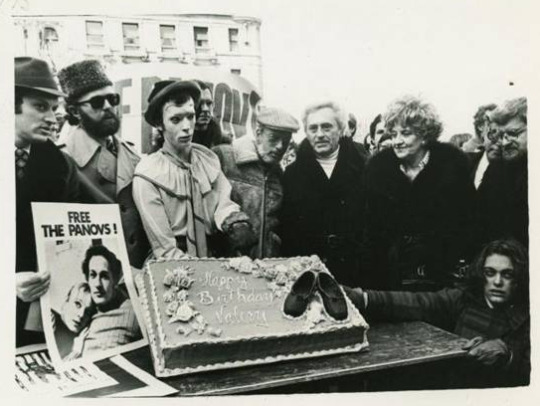by Andrey Filimonov
View digital materials online at http://digital.cjh.org/2027208

Freedom Birthday Party for Valery Panov at the Plaza Square, NYC, March 12, 1974—Rally on behalf of a Refusenik leading ballet dancer Valery Panov. Pictured on the photo, left to right: Malcolm Hoenlein, founding executive director of the Greater New York Conference on Soviet Jewry; Jerry Goodman, Director of National Conference on Soviet Jewry; actor John Sumakis (as Petrouchka); actor Anthony Perkins; theatrical producer and director Hal Prince; musical theatre lyricist Fred Ebb; actress Hermione Gingold, playwright Paddy Chayevsky, and the assistant director of the Greater New York Conference on Soviet Jewry Margy-Rugh Davis. American Soviet Jewry Movement Photographs Collection, I-495, American Jewish Historical Society
Thanks to generous support from the National Historical Publications & Records Commission (NHPRC), the Center for Jewish History has completed the digitization of more than 75,100 images and 500 audio hours from the American Jewish Historical Society’s Soviet Jewry collections. For more information on the project, click here.
One highlight from the digitized collections includes a photograph of the Freedom Birthday Party for Valery Panov from the National Conference for Soviet Jewry Records.
The leading ballet dancer and choreographer Valery Panov enjoyed a stellar, prolific career in the Soviet Union, leading the best troupes of Leningrad, with many leads in the legendary Kirov Ballet company. However, because he openly criticized the Soviet regime, Panov was not allowed to join the companies on their tours in the West, or to communicate with any of his western colleagues. His career came to a complete halt in 1972, when the Jewish dancer (real last name Shulman) decided to make Aliyah and applied for an exit visa for Israel. He was expelled from Kirov, blacklisted, banned from attending class, evicted from his apartment, tormented by the KGB and eventually imprisoned. The American Soviet Jewry movement organizations ran an unprecedented campaign to free Panov, involving hundreds of celebrities of the stage, screen and the arts, including Laurence Olivier, Anthony Perkins, Jack Gilford and many others. After two years of subjecting Panov and his wife to relentless harassment and forcing him to go on a lengthy hunger strike, the Soviet authorities finally gave in to the pressure from the West, and in 1974 Panov was free to fulfill his dream of living in Israel and performing all over the world.
Andrey Filimonov is an archivist at the Center for Jewish History.
